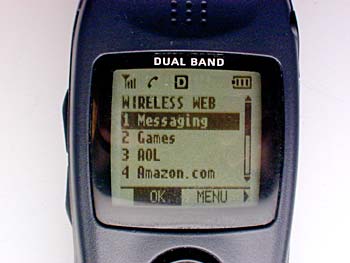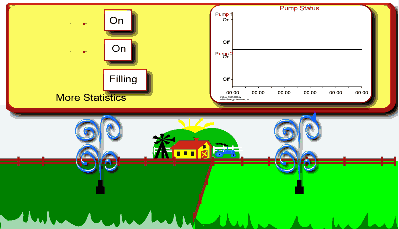Useful Links: www.tomw.net.au/links
IT issues on 666 ABC Canberra Drive with Keri Phillips each Monday at 5:50pm
 With Tom Worthington FACS, Visiting Fellow,
Department of Computer Science, Australian National University
With Tom Worthington FACS, Visiting Fellow,
Department of Computer Science, Australian National University
Internet on Your Mobile Telephone, 15 October 2001
Wireless Application Protocol (WAP)

- What is WAP?
- The Wireless Application Protocol (WAP) is an open, global specification that empowers mobile users with wireless devices to easily access and interact with information and services instantly...
- What type of devices will use WAP?
- Handheld digital wireless devices such as mobile phones, pagers, two-way radios, smartphones and communicators -- from low-end to high-end.
From WHAT IS WAP AND WAP FORUM?, Wireless Application Protocol Forum Ltd, 2001
Unfortunately WAP hasn't been very popular as it is difficult to use Internet applications on a small telephone screen and web pages have to be specially redesigned to work with WAP.
I-mode
I-mode is rival technology from Japan but is not yet available in Australia:
First introduced in Japan in February 1999 by NTT DoCoMo, i-mode is one of the world's most successful services offering wireless web browsing and e-mail from mobile phones. Whereas until recently, mobile phones were used mostly for making and receiving voice calls, i-mode phones allow users also to use their handsets to access various information services and communicate via email.In Japan, i-mode is most popular among young users, 24 to 35 years of age. The heaviest users of i-mode are women in their late 20s. As of November 2000, i-mode had an estimated 14.9 million users.
When using i-mode services, you do not pay for the time you are connected to a website or service, but are charged only according to the volume of data transmitted. That means that you can stay connected to a single website for hours without paying anything, as long as no data is transmitted.
From I-mode FAQ, WestCyber Corporation, 2000 (no longer on-line)
PDAs 
Personal Digital Assistants (PDAs) can have a card added for digital communications. Some are now being released with a built in telephone. These are pocket size (just), but have screen big enough (just) to display web pages:
Wireless PDAs at Gus's cafe
... Gus' Cafe was opened by Augustin "Gus" Petersilka, advicate of the outdoor Viennese cafe. ... Well after Gus' time the cafe has changed from using pencils and note paper for taking orders and now has wireless PDAs. The staff were a bit busy taking orders to stop and explain the system to me, but it appears to use standard Palm III personal digital assistants (PDAs) for taking the orders.
From Networking at Gus' Cafe, 26 January 2001
Short Message Service (SMS)
A much simpler technology which is built into most Australian digital mobile telephones is the Short Message Service (SMS). This allows a brief text message to be sent from telephone to telephone. Messages can also be sent from a computer or a web form and can be forwarded to e-mail or the web.
While SMS is mostly used for recreation, it has more serious uses. The CSIRO are using SMS to improve irrigation monitoring and control on farms:
Improving irrigation efficiency, reducing net recharge of ground waters and minimizing off-farm drainage are critical to sustainable irrigation. As part of its quest to provide practical and cost-efficient tools to improve irrigation and drainage systems, CSIRO has developed a new device called the FullStop. The FullStop is buried in the root zone. During irrigation a wetting front is produced which moves through the root zone. The irrigation is stopped when the wetting front reaches the FullStop detector.
 This system is
being used at at a real
farm in Canberra. A model
farm can be controlled from any phone and monitored on the web. It can
be seen operating at the CSIRO Open Day in
Clunies Ross Street, Acton, on Saturday October 20th and Sunday October 21st,
10am - 4pm.
This system is
being used at at a real
farm in Canberra. A model
farm can be controlled from any phone and monitored on the web. It can
be seen operating at the CSIRO Open Day in
Clunies Ross Street, Acton, on Saturday October 20th and Sunday October 21st,
10am - 4pm.
Telephoning these numbers controls the model farm:
| Number | Command |
| 62167162 | Water on Paddock 1 |
62167163 |
Water off Paddock 1 |
62167164 |
Water on Paddock 2 |
62167165 |
Water off Paddock 2 |
62167166 |
Fill reservoir |
When called there is an engaged tone. If called from a mobile telephone an SMS messages is sent to acknowledge the command.
Suggestions
Suggestions and comments would be welcome. Links to web sites with non-product specific advice would be most useful.
Further Information:
- Other Links topics
- 666 ABC Canberra Drive
- Author's home page
Comments and corrections to: webmaster@tomw.net.au
Copyright © Tom Worthington 2001.